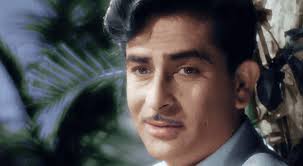 |
| Raj Kapoor (14 December 1924 - 2 June 1988) |
Ranbirraj Kapoor, Peshawar, India (now Pakistan), (Born - 14 December 1924, Died - 2 June 1988)
Raj Kapoor is the quintessential Bombay industry filmmaker of the Nehru era. His career spans the first four decades following independence, from 1947 to 1988, coinciding with Nehruvian socialism. In 1991 socialism was abandoned in favor of "liberalization," opening India's economy to the West. In the 1950s Kapoor translated his own admiration and his generation's enthusiasm for Prime Minister Nehru's vision into extremely popular Hindi films, which he infused with his unique mix of populist politics and sentimentality.
 |
| Prithviraj Kapoor |
Raj Kapoor's father, Prithviraj Kapoor, was an established film actor by the 1940s, and Raj's career developed rapidly. After minor roles and his debut as a leading man in Neel Kamal (Blue Lotus, 1947), he acted in and directed Aag ( Fire , 1948), followed by successes as actor in and director of Barsaat ( Rain , also known as The Monsoons , 1949), and as actor in Andaz ( A Matter of Style , 1949), the latter two films pairing him unforgettably with the actress Nargis. In 1951 he launched his own studio, R. K. Films, which his son, Randhir, took over in 1988 (his granddaughters, Karisma and Kareena Kapoor, also joined the film industry in the late 1980s and 1990s, respectively).
Kapoor chose dramatic dichotomies to play up the conflicts that Hindi films emphasize: between city and country, modernity and tradition, West and East, rich and poor. His protagonists, inevitably underprivileged, are drawn inexorably to the city, only to discover the pervasive corruption and danger lurking beneath its glossy surface. This exposition reinforces the protagonist's moral fortitude to surmount his travails and, together with his love interest, surge toward a joyous future while at the same time apparently valorizing "Indian" values. Conscious of international cinema, Kapoor paid homage to Charlie Chaplin by adapting the figure of the tramp, and the narratives unfold from his point of view in the greatest R. K. Films of the 1950s, Awaara ( The Vagabond , 1951) and Shri 420 ( Mr. 420 , 1955), both of which he starred in and directed. Kapoor became an unofficial ambassador of Indian cinema; he was warmly received in the Soviet Union when he visited in the 1950s, and his popularity spread in the Middle East, China, and Africa, where songs from his films were translated into local languages.
In the postwar era stars were powerful figures, and their offscreen lives mediated the public discourse on morality. Raj Kapoor's extended affair with co-star Nargis was a scandal he circumvented by staying in his marriage and representing himself in the public eye as a "family man," a family that is now virtually a film industry empire built over four generations. Deftly combining "art and commerce"—his functional definition of popular cinema—Kapoor was a phenomenal success in the 1950s and 1960s. In the 1970s and 1980s his output dwindled dramatically. Barring the hit teen romance Bobby (1973), in which he did not appear, his often ambitious and thinly autobiographical films from these decades lost touch with the popular mood and failed at the box office, oddly paralleling the troubles besetting the Nehruvian project.

No comments:
Post a Comment